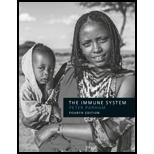
Introduction:
The T-cell receptors are entities present on the surface of T-cells that recognize and bind to antigenic peptides associated with MHC complexes.
Answer to Problem 1Q
Correct answer:
The correct answer are option (c) and option (e).
Explanation of Solution
Explanation/justification for the correct answer:
Option (c) and option (e) are the features that distinguish T-cell receptors from immunoglobulins.
A T-cell receptor is never secreted subsequent to antigen-encounter. On the contrary naïve B-cells are responsible for antigen encounter. They bind antigens that complement to the antibodies bound to their membranes. These B-cells then directly release antibodies to the bloodstream to bind to antigens. The T-cell receptors bind to antigenic epitopes presented to them in an associated form with the MHC complexes. This is a major difference between immunoglobulins and T-cell receptors. Thus, option (c) is the correct option.
T-cell receptors are used solely for the purpose of antigen recognition and not for effector function. The Fc domain of immunoglobulins is involved in their effector functions, which include a coating over pathogens followed by agglutination reactions and others. The T-cell receptors however are only involved in recognition and binding of the antigenic epitopes. Such binding relay a series of biochemical signaling events to bring out the desired effects. Hence, option (e) is a functional difference between the immunoglobulins and T-cell receptors.
Explanation for the incorrect answer:
Option (a) is a similarity between immunoglobulins and T-cell receptors. Both antibodies and T-cell receptors are generated through somatic rearrangements. The genes of the variable regions in both these families undergo similar rearrangements. Hence, this option is an incorrect choice.
Option (b) states that the T-cell repertoire encompasses a very large degree of diversity. This diversity is attributed to the genetic rearrangements in the variable-gene region that gives rise to many combinations randomly. Similar is the diversity in immunoglobulins. Hence, this choice is a similarity and not a point of distinction.
Option (d) states that the variable region of the T-cell receptors contains complementarity-determining regions that interact with antigen. The variable region in both immunoglobulins and T-cell receptors are involved in the interaction between the antigenic sequences called epitopes. Hence, this option is not a point of difference.
Though encoded by a different family of genes the immunoglobulins and the T-cell receptors both share many features in common yet have some distinct differences.
Want to see more full solutions like this?
 Human Anatomy & Physiology (11th Edition)BiologyISBN:9780134580999Author:Elaine N. Marieb, Katja N. HoehnPublisher:PEARSON
Human Anatomy & Physiology (11th Edition)BiologyISBN:9780134580999Author:Elaine N. Marieb, Katja N. HoehnPublisher:PEARSON Biology 2eBiologyISBN:9781947172517Author:Matthew Douglas, Jung Choi, Mary Ann ClarkPublisher:OpenStax
Biology 2eBiologyISBN:9781947172517Author:Matthew Douglas, Jung Choi, Mary Ann ClarkPublisher:OpenStax Anatomy & PhysiologyBiologyISBN:9781259398629Author:McKinley, Michael P., O'loughlin, Valerie Dean, Bidle, Theresa StouterPublisher:Mcgraw Hill Education,
Anatomy & PhysiologyBiologyISBN:9781259398629Author:McKinley, Michael P., O'loughlin, Valerie Dean, Bidle, Theresa StouterPublisher:Mcgraw Hill Education, Molecular Biology of the Cell (Sixth Edition)BiologyISBN:9780815344322Author:Bruce Alberts, Alexander D. Johnson, Julian Lewis, David Morgan, Martin Raff, Keith Roberts, Peter WalterPublisher:W. W. Norton & Company
Molecular Biology of the Cell (Sixth Edition)BiologyISBN:9780815344322Author:Bruce Alberts, Alexander D. Johnson, Julian Lewis, David Morgan, Martin Raff, Keith Roberts, Peter WalterPublisher:W. W. Norton & Company Laboratory Manual For Human Anatomy & PhysiologyBiologyISBN:9781260159363Author:Martin, Terry R., Prentice-craver, CynthiaPublisher:McGraw-Hill Publishing Co.
Laboratory Manual For Human Anatomy & PhysiologyBiologyISBN:9781260159363Author:Martin, Terry R., Prentice-craver, CynthiaPublisher:McGraw-Hill Publishing Co. Inquiry Into Life (16th Edition)BiologyISBN:9781260231700Author:Sylvia S. Mader, Michael WindelspechtPublisher:McGraw Hill Education
Inquiry Into Life (16th Edition)BiologyISBN:9781260231700Author:Sylvia S. Mader, Michael WindelspechtPublisher:McGraw Hill Education





